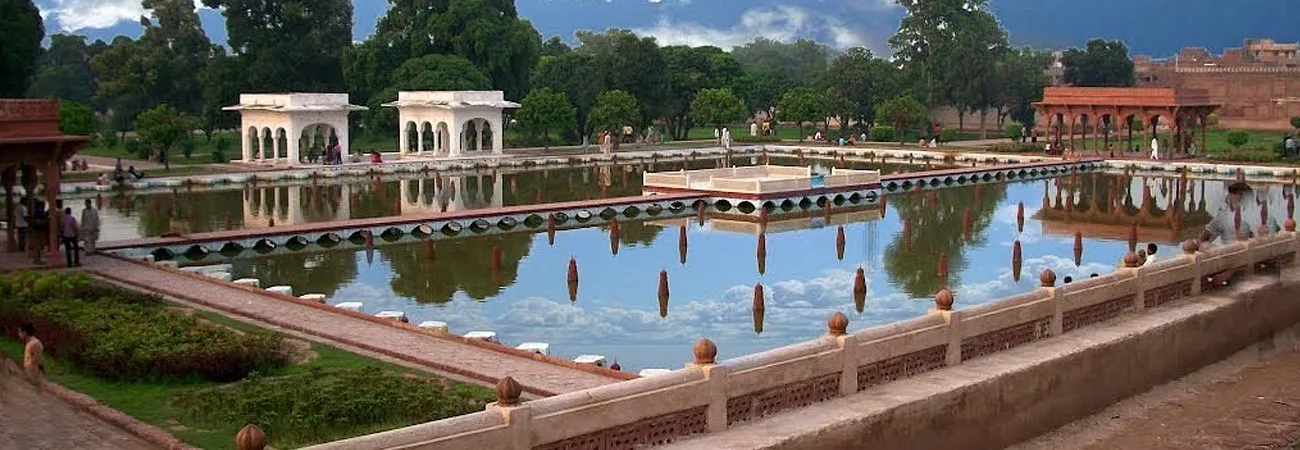i ECONOMY
Promotion of both Shalamar Gardens and Lahore Fort —Pakistan’s grand archaeological assets — as tourist spots is the need of the hour to attract international tourists. Global promotion of this historic treasure trove will increase the footfall of international tourists. It not only showcases the heritage but also offers a window of opportunity to boost the tourist sector. “Increase in the number of international tourists will bring revenues to the cash-strapped state coffers and create a soft image of the country abroad,” said Muhammad Iqbal Khan Manj, Deputy Director Archaeology (North), Lahore Head Office, while talking to WealthPK. He said both Lahore Fort and Shalamar Gardens were the Mughal era monuments. Shalamar Gardens was a unique creation by Shah Jahan. Inspired by the Eden-like gardens, he planned a beautiful garden consisting of three terraces with different themes. The upper terrace was named ‘Farah Baksh’ (Conferred of pleasure); the middle was called ‘Faiz Baksh’ (Conferred of goodness), while the lower terrace was christened ‘Hayat Baksh’ (Conferred of life).
There were about 410 fountains jetting out water with the help of a unique non-mechanical hydraulic system. Further excavation can reveal more wonders about this system. A blend of both Turkish and Mughal architecture can be seen there. The edifice of this garden started around 1641 and was completed in 18 months. Discussing the Lahore Fort, Manj said that a thorough visit to this fort revealed the rise and fall of different eras. Lahore Fort has seen a series of periods, from the Mughal to the Sikh era and the colonial period at last. However, an interesting fact was revealed after the deep excavation of its surroundings in 1958. A gold coin belonging to the Mehmood of Ghazna was discovered (Now, it is in the National Museum, Karachi). This finding changed the entire history of this fort. Further research showed that before the construction of the known Lahore Fort built with red sandstone and baked clay bricks, a mud fort belonging to the times of Mehmood of Ghazna existed there.
According to the historical records, the walled city, the current Lahore, was established on a high dune. To protect the city from invaders, the mud fort was built at the top of a mound. It was a tradition at that time that military camps were established on altitudes to watch the intruders. The period of Mahmood of Ghazna began around 1,000 years. The mud fort and recovery of the coin prove that the first foundation of the fort was laid by Mehmood of Ghazna. After him, this mud fort got its true grandeur in the Mughal era. Mughal Emperor Akbar the Great built many gates to enter the fort from different directions. The most famous ones were Akbari Gate, and Masiti Gate (this gate is closed these days, Mariam Zamani mosque is attached to it). Akbari Gate was the first built using the red sandstone and baked clay bricks in 1566. ‘Jharoka Darshan’ (a facade arched place for imperials to show themselves to people) and ‘Deewan-e-Aam’ (a place to see commoners), were also designed and built during his reign. After Akbar the Great, the Bed Chamber of Jehangir or the Jehangir Quadrangle was fashioned. Now, it is converted into a museum art gallery displaying Mughal paintings. Alamgir also made additions to the fort. ‘Alamgiri Gate’ is one of the examples of construction in his rule.
Shah Jahan was fond of grand and artistic architecture and made many beautiful additions to the Lahore Fort. His masons crafted the ‘Naulakha pavilion’ made of white marble and adorned it with different motifs of precious and semi-precious colourful stones.
This personal chamber was a tribute to his beloved ‘Mumtaz Mahal’. In 1981, it was declared as a world heritage by UNESCO. Sheesh Mahal Courtyard was also one of the wonders of Lahore Fort constructed during his supremacy. After that Sikhs intruded and made little more additions. They built Kharak Singh Haveli, and Mai Jindan Haveli in the fort. Then with the arrival of the British, the colonial period started and the fort was converted into an army camp, stables, etc. This is the history of this fort. Today, three different museums exist in the Lahore Fort, established by the federal Department of Archaeology exhibiting three different historical aspects of the Mughal era. One museum exhibits an armory of that time, the other is dedicated to miniature paintings of that age, and the third one consists of miscellaneous antiquities of that time established in Mai Jindan Haveli of the Sikh period.
Talking to WealthPK, Manager of Tourist Facilitation Centres of Pakistan Tourism Development Corporation (PTDC) Mukhtar Ali said after the 18th Amendment, the development and promotion of tourism was a provincial chapter. The PTDC works as a federal department in the federation and acts as an umbrella to keep the countrywide tourism activities collaborative. All the provincial departments concerning the development and promotion of tourism are its board members. Under the endowment fund, the PTDC supports the provinces for promotion of tourist and archaeological sites. It also promotes these sites in international tourism fairs and exhibitions.
For the last few years, the PTDC has regularly attended international exhibitions and fairs. The World Travel Market (WTM) is the largest platform to exhibit tourist and archaeological sites globally. Regular participation of the PTDC has caused an increase in tourist footfall, as this year about 40,000 foreigners visited Pakistan on the tourist visa. The number of domestic tourist footfalls also increased. Shalamar Gardens and Lahore Fort are the archaeological gems of Pakistan. Through the untiring efforts of the archaeology department, the archaeological sites are well-managed. Some of them are totally conserved and some are undergoing the conservation process. Their promotion is important to strengthening the tourism sector in the country.
Credit: Independent News Pakistan (INP)









